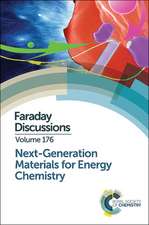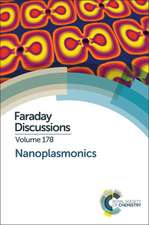Photonic Analog-to-Digital Conversion: Springer Series in Optical Sciences, cartea 81
Autor Barry L. Shoopen Limba Engleză Hardback – 27 mar 2001
| Toate formatele și edițiile | Preț | Express |
|---|---|---|
| Paperback (1) | 946.87 lei 6-8 săpt. | |
| Springer Berlin, Heidelberg – dec 2010 | 946.87 lei 6-8 săpt. | |
| Hardback (1) | 954.45 lei 6-8 săpt. | |
| Springer Berlin, Heidelberg – 27 mar 2001 | 954.45 lei 6-8 săpt. |
Din seria Springer Series in Optical Sciences
- 24%
 Preț: 945.47 lei
Preț: 945.47 lei - 18%
 Preț: 1850.21 lei
Preț: 1850.21 lei - 18%
 Preț: 2124.06 lei
Preț: 2124.06 lei - 20%
 Preț: 568.47 lei
Preț: 568.47 lei - 18%
 Preț: 1118.93 lei
Preț: 1118.93 lei - 18%
 Preț: 999.76 lei
Preț: 999.76 lei - 18%
 Preț: 957.62 lei
Preț: 957.62 lei - 18%
 Preț: 892.11 lei
Preț: 892.11 lei - 15%
 Preț: 648.56 lei
Preț: 648.56 lei - 18%
 Preț: 1838.07 lei
Preț: 1838.07 lei -
 Preț: 379.86 lei
Preț: 379.86 lei - 18%
 Preț: 1392.95 lei
Preț: 1392.95 lei - 18%
 Preț: 1232.89 lei
Preț: 1232.89 lei - 18%
 Preț: 1568.95 lei
Preț: 1568.95 lei - 18%
 Preț: 2095.49 lei
Preț: 2095.49 lei - 18%
 Preț: 1227.84 lei
Preț: 1227.84 lei - 15%
 Preț: 643.65 lei
Preț: 643.65 lei - 18%
 Preț: 954.45 lei
Preț: 954.45 lei - 18%
 Preț: 947.35 lei
Preț: 947.35 lei - 18%
 Preț: 1241.55 lei
Preț: 1241.55 lei - 18%
 Preț: 947.04 lei
Preț: 947.04 lei -
 Preț: 392.21 lei
Preț: 392.21 lei - 18%
 Preț: 997.53 lei
Preț: 997.53 lei - 18%
 Preț: 1562.31 lei
Preț: 1562.31 lei - 18%
 Preț: 1110.24 lei
Preț: 1110.24 lei - 15%
 Preț: 651.19 lei
Preț: 651.19 lei -
 Preț: 414.69 lei
Preț: 414.69 lei - 18%
 Preț: 952.57 lei
Preț: 952.57 lei - 15%
 Preț: 641.03 lei
Preț: 641.03 lei - 15%
 Preț: 635.80 lei
Preț: 635.80 lei
Preț: 954.45 lei
Preț vechi: 1163.97 lei
-18% Nou
Puncte Express: 1432
Preț estimativ în valută:
182.64€ • 195.30$ • 152.28£
182.64€ • 195.30$ • 152.28£
Carte tipărită la comandă
Livrare economică 18 aprilie-02 mai
Preluare comenzi: 021 569.72.76
Specificații
ISBN-13: 9783540413448
ISBN-10: 3540413448
Pagini: 352
Ilustrații: XIII, 334 p.
Dimensiuni: 155 x 235 x 27 mm
Greutate: 0.7 kg
Ediția:2001
Editura: Springer Berlin, Heidelberg
Colecția Springer
Seria Springer Series in Optical Sciences
Locul publicării:Berlin, Heidelberg, Germany
ISBN-10: 3540413448
Pagini: 352
Ilustrații: XIII, 334 p.
Dimensiuni: 155 x 235 x 27 mm
Greutate: 0.7 kg
Ediția:2001
Editura: Springer Berlin, Heidelberg
Colecția Springer
Seria Springer Series in Optical Sciences
Locul publicării:Berlin, Heidelberg, Germany
Public țintă
ResearchCuprins
1. Introduction.- 1.1 The Role of A/D Conversion.- 1.2 Key Technological Challenges.- 1.3 Motivation for Photonic A/D Approaches.- 1.4 Organization of this Book.- 2. Performance Characteristics of Analog-to-Digital Converters.- 2.1 A/D Converter Characteristics.- 2.2 Sampling and Conversion Rate Characteristics.- 2.3 Performance Measures.- 2.4 Performance Degradations.- 2.16 Aperture Jitter.- Summary.- 3. Approaches to Analog-to-Digital Conversion.- 3.1 A/D Converter Coding Schemes.- 3.2 Nyquist-Rate Converter Architectures.- 3.3 Oversampled A/D Conversion.- 3.4 Parallel Oversampling A/D Conversion.- Summary.- 4. Photonic Devices for Analog-to-Digital Conversion.- 4.1 Mach—Zehnder Interferometers.- 4.2 Optical Waveguide Switches.- 4.3 Acousto-Optic Devices.- 4.4 Multiple Quantum Well Devices.- 4.5 Smart Pixel Technology.- Summary.- 5. Nyquist-Rate Photonic Analog-to-Digital Conversion.- 5.1 Electro-Optic A/D Conversion Based on a Mach—Zehnder Interferometer.- 5.2 Optical Folding-Flash A/D Converter.- 5.3 Matrix-Multiplication and Beam Deflection.- 5.4 Other Approaches to Photonic A/D Conversion.- Summary.- 6. Oversampled Photonic Analog-to-Digital Conversion.- 6.1 Oversampling Photonic A/D Conversion.- 6.2 Optical Oversampled Modulators.- 6.3 The Digital Postprocessor.- 6.4 Performance Analysis.- 6.5 Experimental Proof-of-Concept Photonic Modulator Demonstration.- Summary.- 7. Low Resolution, Two-Dimensional Analog-to-Digital Conversion: Digital Image Halftoning.- 7.1 Introduction.- 7.2 Approaches to Halftoning.- 7.3 The Error Diffusion Algorithm.- 7.4 Neural Network Formalism.- 7.5 The Error Diffusion Neural Network.- 7.6 Quantitative Performance Metrics.- 7.7 Performance Analysis.- 7.8 Extensions to Color.- Summary.- 8. A Photonic-Based Error Diffusion NeuralNetwork.- 8.1 First-Generation CMOS-SEED Error Diffusion Neural Array.- 8.2 Second-Generation CMOS-SEED Error Diffusion Neural Array.- 8.3 OPTOCHIP: A 2-D Neural Array Employing Epitaxy-on-Electronics.- 8.4 Extensions: A Photonic Error Diffusion Filter.- Summary.- 9. Photonic A/D Conversion Based on a Fully Connected Distributed Mesh Feedback Architecture.- 9.1 Temporal and Spatial Error Diffusion.- 9.2 Spatially Distributed Oversampled A/D Conversion..- 9.3 A 2-D Fully Connected Distributed Mesh Feedback Architecture.- 9.4 A/D Conversion Using Spatial Oversampling and Error Diffusion.- 9.5 Three-Dimensional Extensions.- Summary.- 10. Trends in Photonic Analog-to-Digital Conversion.- 10.1 Time-Interleaving A/D Converter Architectures.- 10.2 Photonic Channelized A/D Architectures.- 10.3 Time-Stretching Using Dispersive Optical Elements.- 10.4 Ultra-Fast Laser Sources with Low Jitter.- 10.5 Novel Optical Sampling Techniques.- 10.6 Broadband Optical Modulators and Switches.- Summary.- References.
Recenzii
From the reviews of the first edition:
"This book is intended to serve as a resource for scientists, engineers, and students interested in performance characteristics and measures of A/D converters, classical A/D conversion techniques, and photonic approaches to A/D conversion. … The book is well organized and the text easily understandable. … It is a book which should be available in any University library." (D.H. Miller, Optik, Vol. 117, 2006)
"The book has a readable style unlike others. … The book starts off with a simple to read introduction. … It would be useful to people who already had some knowledge in the field and would like an overview, such as an academic wishing to form a new course." (Justin Blows, The Physicist, Vol. 38 (5), 2001)
"This book is intended to serve as a resource for scientists, engineers, and students interested in performance characteristics and measures of A/D converters, classical A/D conversion techniques, and photonic approaches to A/D conversion. … The book is well organized and the text easily understandable. … It is a book which should be available in any University library." (D.H. Miller, Optik, Vol. 117, 2006)
"The book has a readable style unlike others. … The book starts off with a simple to read introduction. … It would be useful to people who already had some knowledge in the field and would like an overview, such as an academic wishing to form a new course." (Justin Blows, The Physicist, Vol. 38 (5), 2001)
Textul de pe ultima copertă
Photonic-based A/D conversion has received and continues to receive considerable attention as an alternative approach to providing enhanced resolution and speed in high-performance applications. Some of the potential advantages of using pho- tonic technologies are high-speed clocking, broadband sam- pling, reduced mutual interference of signals, and compati- bility with existing photonic-based systems. This book pro- vides a comprehensive look at the application of photonic devices and architectures to the problem of A/D conversion. It includes a complete description of A/D converter performance characteristics, the various approaches to A/D conversion, and an introduction to several photonic devices used in photonic A/D converters, and it includes a detailed treatment of the application of both temporal and spatial oversampling techniques to photonic A/D conversion. It shows progress made, discusses current research, and provides a glimpse of several promising future architecutres and technologies.
Caracteristici
Single up-to-date monograph in this fast progressing area available Focusses on photonic A/D conversion and describes also future development End-of-chapter summaries Highly illustrated with many examples Includes supplementary material: sn.pub/extras
















